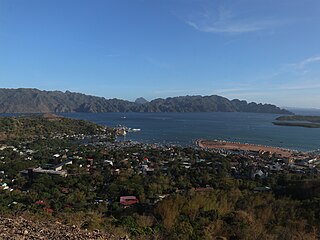Related Research Articles

Palawan, officially the Province of Palawan, is an archipelagic province of the Philippines that is located in the region of Mimaropa. It is the largest province in the country in terms of total area of 14,649.73 km2 (5,656.29 sq mi). The capital and largest city is Puerto Princesa which is geographically grouped with but administered independently from the province. Palawan is known as the Philippines' Last Frontier and as the Philippines' Best Island.

Busuanga, is the largest island in the Calamian Group of islands in the province of Palawan in the Philippines. Busuanga Island is the second largest island in the province after Palawan island itself. The island is located halfway between the islands of Mindoro and Palawan with the South China Sea located to the west and the Sulu Sea to the southeast. South of the island are the two other major islands of the Calamian Group: Culion Island and Coron Island. The western third of the island is under the municipality of Busuanga and the eastern two-thirds belong to the municipality of Coron.

Coron, officially the Municipality of Coron, is a 1st class municipality in the province of Palawan, Philippines. According to the 2020 census, it has a population of 65,855 people.
Palawan is the largest island of the province of Palawan in the Philippines and fifth-largest by area and tenth-most populous island of the country, with a total population of 994,101 as of 2020 census. The northwest coast of the island is along the Palawan Passage in the eastern South China Sea, while the southeast coast forms part of the northern limit of the Sulu Sea. Much of the island remains traditional and is considered by some as under-developed. Abundant wildlife, jungle mountains, and some white sandy beaches attract many tourists, as well as international companies looking for development opportunities.

Culion, officially the Municipality of Culion, is a 3rd class municipality in the province of Palawan, Philippines. According to the 2020 census, it has a population of 23,213 people.

Palawan, the largest province in the Philippines, is home to several indigenous ethnolinguistic groups namely, the Kagayanen, Tagbanwa, Palawano, Taaw't Bato, Molbog, and Batak tribes. They live in remote villages in the mountains and coastal areas.

The Calamian Islands or the Calamianes is a group of islands in the province of Palawan, Philippines. It includes:

The Tagbanwa people are an indigenous peoples and one of the oldest ethnic groups in the Philippines, mainly found in central and northern Palawan. Research has shown that the Tagbanwa are possible descendants of the Tabon Man, thus making them one of the original inhabitants of the Philippines. They are a brown-skinned, slim, and straight-haired ethnic group.
The Palawano languages are spoken in the province of Palawan in the Philippines, by the Palawano people.
The Agutaynen language is spoken on Agutaya Island in the province of Palawan in the Philippines.
The Kagayanen language is spoken in the province of Palawan in the Philippines. It belongs to the Manobo subgroup of the Austronesian language family and is the only member of this subgroup that is not spoken on Mindanao or nearby islands.

The Sama–Bajaw languages are a well-established group of languages spoken by the Sama-Bajau peoples of the Philippines, Indonesia, and Malaysia.
Kupang Malay or simply the Kupang language is a Malay-based creole language spoken in Kupang, East Nusa Tenggara, which is on the west end of Timor Island. Kupang Malay is presently used as a lingua franca for inter-ethnic communication, and it also has native speakers.
Seko Padang is an Austronesian language spoken in the North Luwu Regency of South Sulawesi, Indonesia. Together with Seko Tengah, Panasuan and Budong-Budong, it belongs to the Seko branch of the South Sulawesi subgroup.
Seko Tengah is an Austronesian language spoken in the North Luwu Regency of South Sulawesi, Indonesia. Together with Seko Padang, Panasuan and Budong-Budong, it belongs to the Seko branch of the South Sulawesi subgroup.
Aborlan Tagbanwa is spoken on Palawan Island in the Philippines. It is not mutually intelligible with the other languages of the Tagbanwa people.
Central Tagbanwa is spoken on Palawan Island in the Philippines. It is not mutually intelligible with the other languages of the Tagbanwa people.
Batak is an Austronesian language spoken by the Batak people on Palawan Island in the Philippines. It is sometimes disambiguated from the Batak languages as Palawan Batak.
Panasuan is an Austronesian language spoken in the border area of West Sulawesi and South Sulawesi provinces, Indonesia. Together with Seko Padang, Seko Tengah and Budong-Budong, it belongs to the Seko branch of the South Sulawesi subgroup.
Budong-Budong is an Austronesian language of Sulawesi, Indonesia, spoken in the village of Tongkou, Budong-Budong District, Central Mamuju Regency. Together with Seko Padang, Seko Tengah and Panasuan, it belongs to the Seko branch of the South Sulawesi subgroup.
References
- ↑ "Tagbanwa, Calamian". Ethnologue.
- ↑ Calamian Tagbanwa at Ethnologue (18th ed., 2015) (subscription required)
- ↑ Himes, Ronald S. (2006). The Kalamian Microgroup of Philippine Languages (PDF). Paper presented at the Tenth International Conference on Austronesian Linguistics, 17–20 January 2006, Puerto Princesa City, Palawan, Philippines.
- 1 2 Reid, Lawrence A. (1971). Philippine Minor Languages: Word Lists and Phonologies. University of Hawai'i Press. p. 42.
- ↑ Ruch, J. Stephen; Quakenbush, Edward (2006). Pronoun Ordering and Marking in Kalamianic (PDF). Paper presented at the Tenth International Conference on Austronesian Linguistics, 17–20 January 2006, Puerto Princesa City, Palawan, Philippines. Retrieved 27 May 2020.